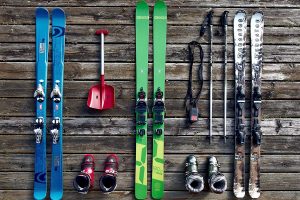
What’s the best way to store your ski gear over the summer?
Storing your skis, boots and outerwear properly over the summer means they’ll perform better and last longer, plus look and feel good as new when you break them again next winter. A much better alternative to taking a slightly rusty pair of cobweb-covered, unwaxed skis from the corner of the garage in November! The end of winter is the best time to get any broken parts fixed and check everything is working the way it should. When you’re preparing for your next season or winter holiday you’ll probably have neither the time or the motivation to fix a ripped jacket or a core shot in your skis. But how should you store your ski gear for summer and how do you prep it for storage? Here’s our quick and easy guide.

Skis
Making sure your skis are stored properly will make a massive difference to how they perform when you take them out again. When left for long periods of time, the bases tend to dry out which isn’t what you want to be trying to fix amid packing and sorting out how you’ll be getting to the airport. A good storage wax will protect your bases from drying out over the summer. But first…
- Do you have any core shots or burrs in the edges that need to be fixed? If so, it’s probably time for a service.
- A base grind will help your skis take to the storage wax but isn’t essential, especially if your skis are still in good condition.
- Make sure your skis are clean. You don’t want dirt clogging up the bindings or getting in the way of a good wax job on the bases. Give them a wipe down before getting them serviced to remove excess grime.
- Get a storage wax – this is the most important aspect of ski storage. A storage wax means applying a generous coat of wax to your skis but not scraping it off, which protects the bases from drying out over the summer months. This way your skis will be ready to go next time you need them. All you need to do is scrape the wax off.
- Finally, store your skis somewhere that’s not too cold and damp, but also not too hot and sunny. Leaving them in direct sunlight can damage the plastic topsheets, while excess damp and cold can cause the edges and binding components to rust.

Boots
Your boots are arguably the most important part of your ski set up and it’s essential to the wellbeing of your feet that you store them properly! Storing your boots is a little easier than packing away your skis and your feet will thank you next winter.
- Taking out your liners and footbeds and letting them dry out fully is the best way to start. This will stop the build up of bacteria and bad smells. Beware of leaving your boots too near a direct heat source like a radiator or fire as this can case the materials to degrade or, if your boots have been stretched out, cause the plastic to retract back to its original shape.
- Once your boots and liners are nice and dry, check all the screws and buckles are nice and tight. Tighten up any loose screws as needed.
- Check the soles of your boots for wear. If you’ve been walking around in them a lot, chances are you might have worn down the heel and toe, which can mean your boots fit less effectively into your bindings. However, some boots have removable toe and heel plates which can be easily replaced.
- Finally, put your liners back in, make sure the tongue is in the correct position and buckle your boots back up. This will help them hold their shape throughout the summer.
- Store your boots in a cool, dry place out of direct sunlight. Somewhere they won’t get damp and smelly or attract mice!

Outerwear
At the end of the winter, your outerwear could end up looking a bit grubby from all that spring skiing. If you have Gore-Tex products or similar, dirt can clog the micro-pores and cause it to perform less effectively. There are some simple steps you can take to make sure your ski clothes are in prime condition for next year!
- Give them a wash with a small amount of mild liquid detergent. Powder detergents, fabric softeners and stain removers can damage the external waterproofing, so stay away from these!
- If you feel like the waterproofing has been less effective, now’s a good time to top it up. Putting your jacket in the tumble dryer on a low setting for around 20 minutes can reactivate it. You can also buy spray-on DWR or waterproofing treatments that can be applied in the wash.
- Before washing or rewaterproofing, always make sure you follow the manufacturer guidelines for your chosen garments. Washing instructions can vary!
- If you have any minor rips or tears, patch it up with some fabric tape or get it repaired by your local seamstress before you forget!
- Make sure you store your outerwear somewhere cool and dry, out of direct sunlight. Direct sunlight can cause the colours to fade and the materials to degrade.

A few other things to think about…
- Take the batteries out of your transceiver
- Make sure your poles, shovel and probe have been fully dried out, too, particularly if you ski with adjustable-length poles.
- Remove the lenses from your goggles and let them dry thoroughly before storing in a cool, dry place.
- If you have leather gloves, think about topping them up with the manufacturer-recommended weatherproofing treatment. Also make sure they’re nice and dry before putting them away.
- If you don’t have leather gloves, give them a wash, along with your glove liners. That way they’ll be nice and fresh for next season. You might also want to think about washing your hats / balaclavas / neck warmers as well. If your helmet has a removable fabric liner, go ahead and give that a wash, too.
There you have it, how to store your ski gear in a nutshell. At European Snowsport, we partner with the best ski shops in our resorts, Mountain Air in Verbier, Glacier Sport in Zermatt and Premier Alpine Centre in Nendaz. If you need an end-of-season service or any ski gear care products, these guys are the best in the business.
